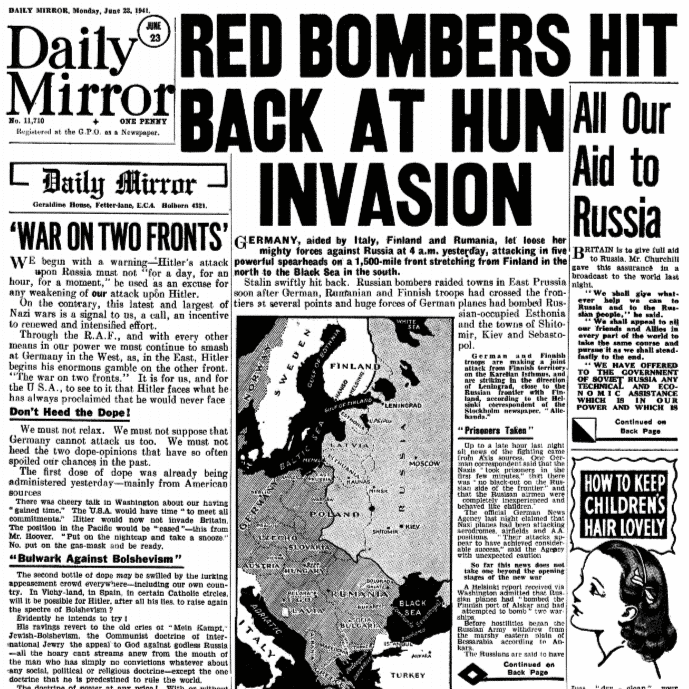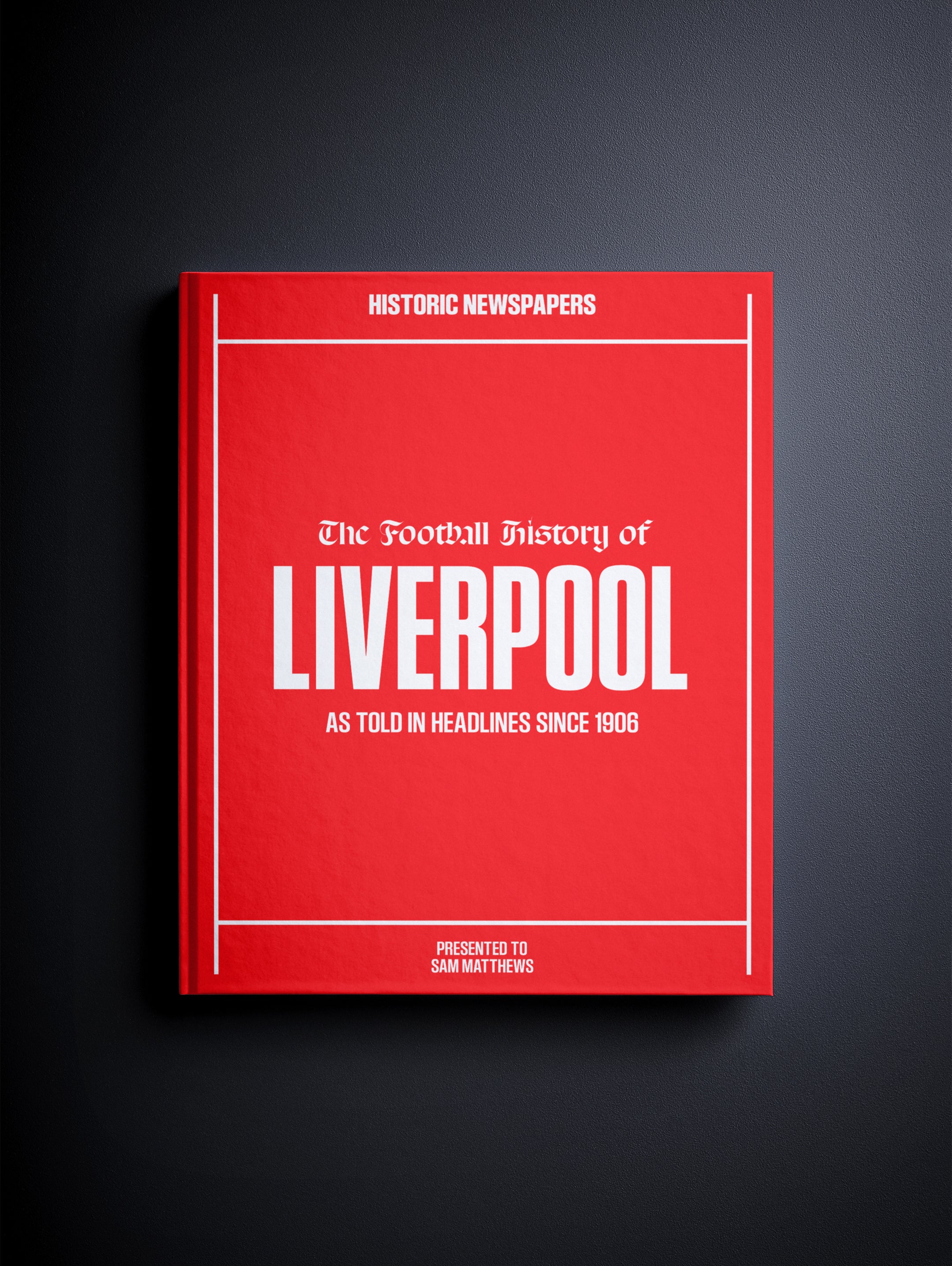On 22nd June 1941, news broke of the German invasion of the Soviet Union, which was the start of the largest military operation in history: Operation Barbarossa.
Operation Barbarossa was the code name given to the German invasion of the Soviet Union, which lasted until 5th December 1941. Aided by Italy, Finland and Romania, Germany began the operation on 22nd June 1941 by attacking across a 1,500 mile front. This invasion was originally given the code name Operation Fritz, but Hitler later chose to rename it after the Holy Roman Emperor Frederick Barbarossa, who also sought to establish German dominance over Europe.
Operation Barbarossa saw the opening up of the Eastern Front to violence and conflict, which led to the Eastern Front seeing more men die fighting than in all other fighting across the world during World War II. The ultimate defeat of the Germans is widely believed to have not only changed the overall political landscape of Europe during World War II but to have changed the entire course of the war.
Our archive is host to actual newspaper reports of each battle as they took place throughout Operation Barbarossa, which you can read alongside other 1941 newspaper headlines outlining the other big events of 1941.
Daily Mirror front page, Monday, June 23, 1941
Turn the page to:
- The German-Soviet Nonaggression Pact of 1939
- Germany’s Initial Attack: What was Operation Barbarossa and What Were the Objectives?
- The Miscalculation of Stalin’s Troops
- The Soviet Union’s Defeat of Nazi Germany
- “Red Bombers Hit Back at Hun Invasion”
- “All-Front Battle On”
- “Big Battle All Day and Night for Leningrad”
- “Moscow ‘Siege’ Proclamation This Morning”
- “Struggle for Kerch”
- “Germans Retreat on 3 Fronts”
The German-Soviet Nonaggression Pact of 1939
Before the start of World War II, Germany and the Soviet Union signed the German-Soviet Nonaggression Pact on 23rd August 1939. This pact was set to last ten years and meant the two countries agreed not to attack each other nor could either country join another group of power that opposes the other country.
Within the pact, there were secret supplementary protocols in which Germany and the Soviet Union divided the whole of eastern Europe up, so both countries had specific areas of influence. The Nonaggression Pact became null and void, however, when the Nazis invaded the Soviet Union in Operation Barbarossa.
Shop our Historic Newspapers book to learn more about WWII through newspaper headlines...

Germany’s Initial Attack: What was Operation Barbarossa and What Were the Objectives?
The element of surprise was fundamental in Germany’s initial attacks on the Soviet Union, with both the air and ground attacks destroying the Soviet forces within the first several hours. These initial attacks left the Red Army almost entirely demobilised and it took several days for the Soviet leaders to appreciate the scale of their initial defeat.
The German attack was initially led from three fronts: one group attacked from East Prussia toward Leningrad (now known as St Petersburg), another struck from southern Poland and the main force advanced from the centre heading straight for Moscow.

Map of Nazi Germany’s initial movements and objectives of Operation Barbarossa
Image: Wikimedia Commons
The Miscalculation of Stalin’s Troops
For Operation Barbarossa, Hitler allocated around 3 million men split up into 150 divisions. Operation Barbarossa became the largest and most powerful invasion in history, with the German forces using 3,000 tanks and 2,500 aircraft, notwithstanding the further power the Germans gained from troops from Italy, Romania and Finland.
However, Germany had underestimated Stalin’s troops massively, a miscalculation that was fatal for the entire operation. Whilst Germany did manage to overturn the Soviet’s forces in their initial attack on 22nd June 1941, they then found new Soviet troops appearing in their path. The Germans had failed to appreciate the mass of troop reserves that Stalin could bring forward to the battle. This led to much of August 1941 being spent by Hitler arguing with his advisers about how to proceed with Operation Barbarossa.
The Soviet Union’s Defeat of Nazi Germany
The ultimate question is how successful was Operation Barbarossa for Nazi Germany? Or perhaps the better question is what caused Nazi Germany’s defeat? Was it down to the success of the Soviet Union’s defensive moves or was their defeat solely due to the intensity of the Russian winter?
The Russian winter certainly played a role in the outcome of Operation Barbarossa, as the German offensive had been greatly damaged by the cold temperatures, which had been the most severe temperatures in quite some time. By November 1941, many of the German men had been lost to frostbite due to a lack of winter clothing provisions. The icy temperatures also froze much of their machinery, like transport, tanks and aircraft. Of course, the Soviets were far more effective in fighting during the winter than the Germans, thus giving them an extra edge.
On 6th December 1941, a Soviet commander commenced a large counteroffensive just as the German offensive attack on Moscow weakened. This counterattack formed part of the Soviet winter counteroffensive, which eventually came to an end on 7th January 1942 having pushed the German armies back and away from Moscow. This would become known as the Battle of Moscow, which the Germans lost, losing over 800,000 of their men.

Three German Soldiers in Wehrmacht
Image: Wikimedia Commons
“Red Bombers Hit Back at Hun Invasion”
Headline from Daily Mirror front page, Monday, June 23 1941
On 23rd June 1941, the Daily Mirror first reported about Operation Barbarossa:
“Germany, aided by Italy, Finland and Rumania, let loose her mighty forces against Russia at 4a.m. yesterday, attacking in five powerful spearheads on a 1,500-mile front stretching from Finland in the north to the Black Sea in the south.”
The front page article describes how “Stalin swiftly hit back” with Russian bombers after “huge forces of German planes had bombed Russian-occupied Esthonia and the towns of Shitomir, Kiev and Sebastopol.”
The article continued to describe how the Germans and Finnish had joined forces:
“German and Finnish troops are making a joint attack <…> striking in the direction of Leningrad”
Apparently news was spreading fast about the fighting, with the reporter quoting one German correspondent who said:
“the Nazis ‘took prisoners in the first few minutes’, that there was ‘no black-out on the Russian side of the frontier; and that the Russian airmen were completely inexperienced and behaved like children.”
This front page features the first of many Operation Barbarossa newspaper articles detailing the violence and events of the operation, with this first article highlighting the initial victory for the Nazis.
Map featured on the Daily Mirror front page, Monday, June 23 1941
“All-Front Battle On”
Two months into the operation, the reporter for the Daily Mirror writes of the previous night’s Moscow communiqué:
“Fierce fighting took place today along the whole front from the White Sea to the Black Sea.”
The battle has progressed significantly since the first newspaper reporting, now with no clear winner or loser. The Moscow communiqué “admitted that <…> Soviet troops had evacuated towns of Kirovograd and Pervomaisk” and also stated:
“The Russians, however, deny the German claim to have encircled Odessa, and declare that the German offensive is being smashed.”
The reporter notes that “the newspaper Pravda” described the German Army as almost thriving, but there were certainly some issues arising amongst Hitler’s men:
“The Germany Army is still powerful, but the myth of invincibility is crushed.”
So, whilst the article describes how “the German armies in the Ukraine have reached their objective”, it is interesting to consider the glimmer of hope the Daily Mirror may have given its readers about the ability to crush the German offensive.
“Big Battle All Day and Night for Leningrad”
The Daily Mirror’s front page features the gruesome depiction of one of the fundamental battles during Operation Barbarossa:
“An immense, bloody battle is going on day and night on the approaches in Leningrad, with the Germans halted by Voroshilov’s army.”
The reporter tells the readers how “German propaganda declaring that Leningrad had almost been taken was pure fantasy,” quoting Soviet Press Chief Lozovsky:
“‘Leningrad is far from being encircled and is not cut off,’ he said. ‘The city maintains communications with the rest of the country by various railways.’”
Meanwhile, there are “Kiev Counter-Attacks,” according to the article’s subheading, as “the Germans yesterday
“At one village near Kiev the Germans lost 15,000 in killed and wounded.”
“Moscow ‘Siege’ Proclamation This Morning”
On 20th October 1941, as the troops began to face the colder months, Operation Barbarossa was front page news once again, as the Daily Mirror reports on the state of siege in Moscow:
“A state of siege was proclaimed in Moscow early this morning, a few hours after Stalin, in an order of the day, had declared, ‘Moscow will be defended to the last.’”
The article goes on to describe which Soviet commander has been entrusted with protecting certain areas of Moscow:
“General Zhukov has been appointed supreme commander of the Russian defence forces operating between sixty and seventy-five miles from Moscow”
The news of Operation Barbarossa on 20th October 1941 was heavily focused on the words of Stalin in his order of the day, with the report quoting Stalin numerous times:
“The population of Moscow <…> is keeping calm and is ready to give the Red Army defending Moscow every possible help.”
Additionally, more news of the success of the Soviet Union’s defensive is reported, but it is clear the Soviet troops have not been entirely successful:
“Moscow’s 250-mile defence line held firmly against even stronger Nazi attacks. The German High Command claimed an important success on the southern front.”
“Struggle for Kerch”
A very brief feature on the front page of the Daily Mirror on 15th November 1941 outlined the attacks on Kerch, with reports received from the German High Command stating:
“Kerch is now being shelled by artillery and is being heavily bombed.”
The reporter acknowledges that the Soviets are “stubbornly holding the enemy at the outer defences of Kerch”, but is clearly not suggesting any battle has been won. The reporter goes on to say that:
“The Russian ‘Commando’ troops are playing havoc with the enemy flanks along the coast.”
However, the article also focuses on “the Moscow front,” stating:
“The Russians report success on both flanks—at Tula, to the south-west, and at Kalinin, to the north-west.”
Whilst this might seem like a success story, the article continues to describe the desperation in the Russians’ fighting and how “they are constantly bringing up reserves.”
Headline from Daily Mirror front page, Saturday, November 15 1941
“Germans Retreat on 3 Fronts”
On 8th December 1941, the Daily Mirror reported of the Germans’ retreat from Moscow a few days prior:
“German forces were compelled to retreat on two Moscow fronts.”
For this article, the reporter focuses on “an unusually frank German broadcast” from the previous night, as this broadcast was a great “
“Our artillery has fired tons of steel for days, but no artillery can possibly smash the system of trenches and the many dug-ins tanks <…> every one of which the Soviets maintain a terrific fire.”
Their retreat is borne out of protection for their men’s lives, as the reporter includes further quotes from the German broadcast:
“Only the utmost ruthlessness and no consideration for life can enable us to advance.”
Headline from Daily Mirror front page, Monday, December 8 1941
Operation Barbarossa had started strong for the Germans but ultimately began to fail during August 1941 when time was lost due to the German leaders debating how to proceed. Whilst the Soviet Union suffered greater losses in their army, they still managed to defeat the Germans. This was a major setback for Hitler and Nazi Germany and consequentially changed the course of World War II.































Follow us